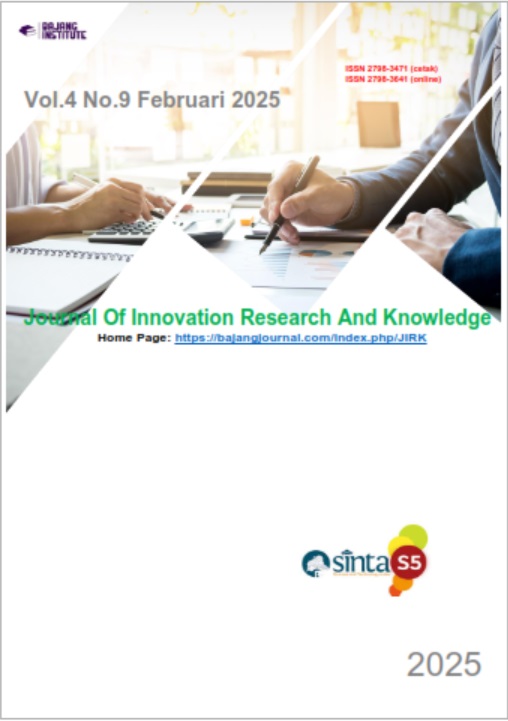HUBUNGAN BERAT BADAN LAHIR RENDAH (BBLR) DENGAN KEJADIAN STUNTING PADA ANAK USIA 2-5 TAHUN DI WILAYAH KERJA PUSKESMAS SLEMAN
DOI:
https://doi.org/10.53625/jirk.v4i9.9689Keywords:
Under-five Children, Stunting, Low Birth Weight (LBW)Abstract
Background: Stunting is a significant health challenge in Indonesia and has become a key target for nutritional improvement in the country. According to data from the DIY Health Office, the prevalence of stunting was 16.4% in 2022. Sleman Regency ranked third, with a prevalence of 15.0%, while the prevalence of stunting in the Puskesmas (community Health Center) Sleman service area was 3.53% in 2023. Globally, 15.5% of births, or approximately 20 million children annually, experience low birth weight (LBW). In 2023, 8.79% of LBW cases were recorded in Puskesmas Sleman.
Objective: This study aims to investigate the relationship between low birth weight (LBW) and the incidence of stunting in children aged 2–5 years in the Puskesmas Sleman service area.
Method: This study employed quantitative design with survey method and case-control approach. Statistical analysis was conducted using the Chi-square test. The study population consisted of 1,538 under-five children. The sampling technique used total sampling for the case group and random sampling for the control group. The total sample size, based on the collected data, was 140 participants, comprising 70 cases and 70 controls. Data collection was performed using records from Posyandu (Integrated Health Post) registration reports, entered into a structured data collection format, and guided by a checklist.
Results: Among the respondents, 24 (17.1%) experienced LBW, while 116 (82.9%) did not. The number of respondents with stunting was 70 (50.0%), and those without stunting also totaled 70 (50.0%). The Chi-square test showed a p-value of 0.000, and the odds ratio (OR) was 9.571. Since the p-value is less than 0.05, a significant relationship exists between LBW and the incidence of stunting. Children with LBW were found to have a 9.571 times higher risk of stunting compared to those without LBW. It is recommended to optimize socialization programs for pregnant women to prevent LBW and stunting. Ensuring every family member maintains good nutritional status, especially children, can help improve the nutritional status of children aged 2–5 years and contribute to better outcomes as they grow older.
References
Butar-Butar, et al., (2024). Determinan Kejadian Stunting di Wilayah Kerja Puskesmas Edison Jaar Tahun 2023. Journal Healthy Purpose, 3(1), 145-149.
Dinkes (2021). Kota Yogyakarta. Jurnal Kajian Ilmu Administrasi Negara, 107(38), 107–126. https://journal.uny.ac.id/index.php/natapraja/article/view/12619
Dinas Kesehatan DIY. (2022). Dinas Kesehatan D.I Yogyakarta tahun 2022. Dinas Kesehatan Daerah Istimewa Yogyakarta Tahun 2022, 76.
Fitria, A. R., Suhartini, T., & Supriyadi, B. (2024). Hubungan Berat Badan Lahir Rendah (BBLR) dengan Kejadian Stunting pada Anak Usia< 5 Tahun. Jurnal Penelitian Perawat Profesional, 6(1), 49-56.
Hanisa, D. E. (2024). Hanisa, et al The Correlation between History of Low Birth Weight. Jurnal Kesehatan Cendikia Jenius, 1(3), 1-6.
Hariani, et al. (2024). Hubungan Berat Badan Lahir Rendah Dengan Kejadian Stunting Pada Anak Usia 1-5 Tahun Di Wilayah Kerja Puskesmas Jorongan. ASSYIFA : Jurnal Ilmu Kesehatan.
Harper A, Rothberg A, Chirwa E, Sambu W, Mall S. Household Food Insecurity and Demographic Factors, Low Birth Weight and Stunting in Early Childhood: Findings from a Longitudinal Study in South Africa. Matern Child Health J. 2023 Jan;27(1):59-69. doi: 10.1007/s10995-022-03555-7. Epub 2022 Sep 28. PMID: 36169906; PMCID: PMC9516515.
Kamilia, A. (2019). LITERATUR REVIEW Berat Badan Lahir Rendah dengan Kejadian Stunting pada Anak (Low Birth Weight with Stunting in Children). Low Birth Weight with Stunting in Children, 311-315.
Ladi; et al. (2024). Determinan Kejadian Stunting di Wilayah Kerja Puskesmas Edison Jaar Tahun 2023. JURNAL GIZI DAN KESEHATAN, 16(1), 96-112.
Nainggolan, B. G. (2019). Hubungan Berat Badan Lahir Rendah (Bblr) Dengan Kejadian Stunting Pada Anak Usia 1-3 Tahun. Nutrix Journal, 3, 36.
Nashita, C. K. (2023). Hubungan Berat Badan Lahir dengan Pertumbuhan Bayi di TPMB Isnaningsih, S.Tr.Keb Kabupaten Semarang. journal of Holistics and Health Sciences, 5(3), 289-295.
Pratiwi, et all. (2021). Dampak status gizi pendek (stunting) terhadap prestasi belajar: A literature review. Jurnal Ilmiah Ilmu Keperawatan, 10-23.
Sujianti, P. S. (2021). Analisis Faktor yang Berhubungan dengan Stunting pada Usia Todler. Indonesian Journal of Nursing Health Science ISSN, 2(6), 104-112.
Usman et al. (2023). Karakter Unggul melalui Keterlibatan Aktif dalam Urban Farming Radjawali Keguruan dan Ilmu Pendidikan, Fakultas. Maspul Journal of Community Empowerment, 251-257.
Yuningsih, et al. (2022). Hubungan Jenis Kelamin terhadap Kejadian Stunting. Jurnal MID-Z (Midwivery Zigot) Jurnal Ilmiah Kebidanan.
WHO. (2022). WHO recommendations for care of the preterm or low-birth-weight infant. In World Health Organization.













